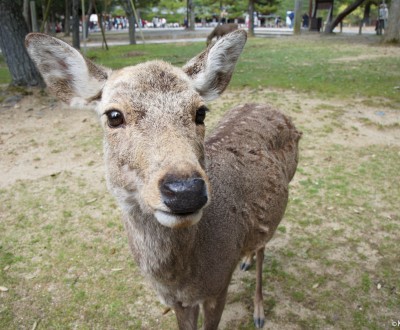Nara Park
The Cornerstone of Nara City
Nara Park is a vast public park spanning over more than 500 hectares from the foot of Mount Wakakusa to the heart of Nara city in Kansai area. Opened in 1880, the "deer’s park" shelters nearly 1,300 shika deer roaming free among the temples, avenues and tourists who came to discover the treasures of the ancient imperial capital.
Nara’s great Park is probably the attraction most massively visited by tourists who have come to spend one or several days in the famous Kansai little town.
On leaving the station, just walk in an eastern direction up the commercial street proudly sporting its souvenirs, mostly derived from the shika deer. After a few minutes, a large vermilion torii ⛩️ gate will loom ahead to signal the entrance of the Nara Park, the actual gateway to most of the town’s tourist attractions.
A vast expanse of 502 hectares – even 660 hectares if you include the Todai-ji, Kofuku-ji and Kasuga Taisha premises – laid out in 1880, the park is not only home to these sublime temples and shrines, but is also worth visiting for its own sake 🍶, obviously largely on account of the natural attraction provided by the shika deer that roam the grounds in complete freedom.
In the video below, you will see the cute animals in their natural environment:
🦌 An Ode to the Shika Deer
The shika (鹿) look very much like our fallow deer and are, to say the least, undaunted! They do not shy away from posing for photos, so impassive are they at the sight of the crowds of tourists visiting the grounds all year round. They are certainly much more interested in whatever food you may have hidden away in your bag than in you, which is why it is wiser not to tempt them for fear of being jostled – more or less gently!
Part of the park’s 1,286 deer (at the last count in July 2020) roam one of its largest expanses, the Tobihino hill. In the Shinto religion, they are believed to be messengers of the gods. They have, moreover, been designated as natural treasures by the town of Nara. Don’t hesitate to respectfully share their natural environment by sitting on the grass for a pleasant break or snack.
The town of Nara organizes a deer call in the park’s main clearing in the early morning, played by a local horn-player. Booking is compulsory.
In the second half of 2017 however, local authorities have decided on the slaughter of 120 deer in Nara’s most rural areas, as they damages the crops of the farmers around the city. In the park, the number of deer has been steadily increasing since the beginning of census in 1955, when they were 378.
In the beginning of summer 2019, the Nara Deer Preservation Foundation sounded the alarm: since March of the same year, 9 deer died from eating plastic bags or forbidden food. In 2020, local companies have thus developed paper bags that are safe to the deer if they happen to eat them.
The Nara Deer Preservation Foundation is funded by the sale of senbei, a 3-4 grams cracker sold in 10 items packages and available at many merchants and shops in the park and its surroundings. It is a treat for the deer, who also eat 5 kilos of grass on a daily basis. In October 2019, along with the VAT rise to 10%, the first price rise of the senbei packet in 28 years occurred: from ¥150 (~US$0.97) to ¥200 (~US$1.29). With 20 million crackers sold each year, the Foundation can expect a yearly ¥100 million (~US$644,878) revenue.
The Covid 🦠 crisis and the absence of foreign tourists during 2020 forced many shika deer to wander away from the park and take risks to find food, as they started to suffer malnutrition.
---
Viewed from above from the Wakakusayama mountain tops, the park’s vast expanse is rather impressive and the view provides a new perspective on the decidedly indispensable Nara platform.


